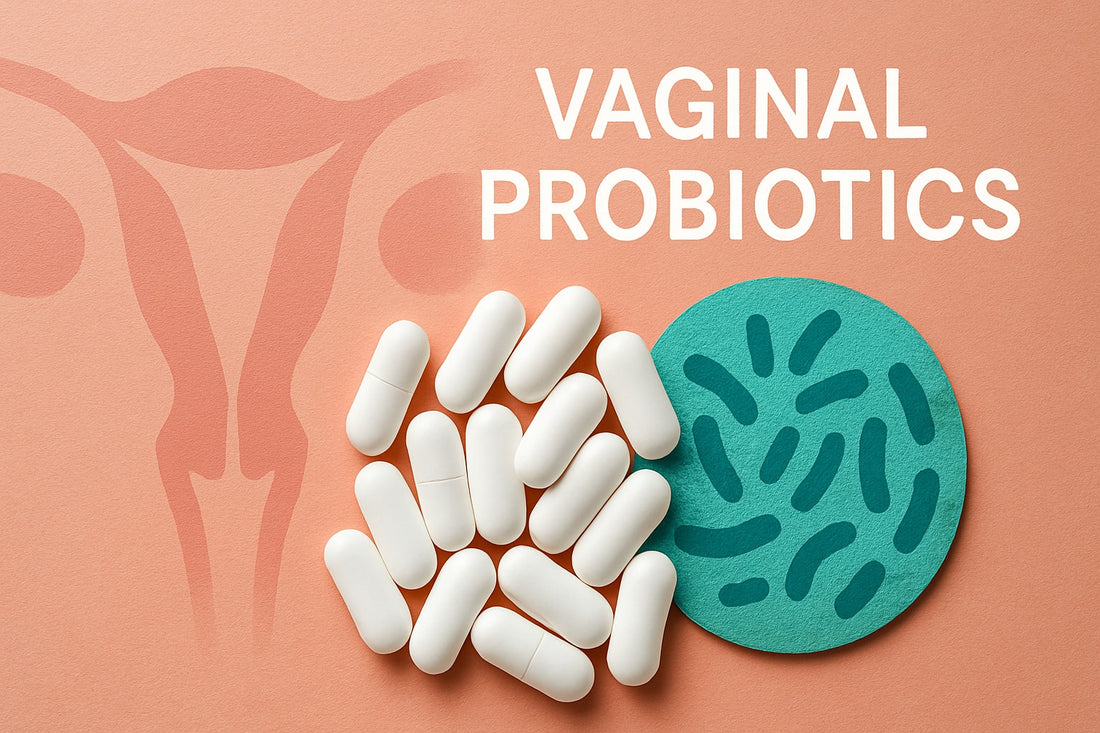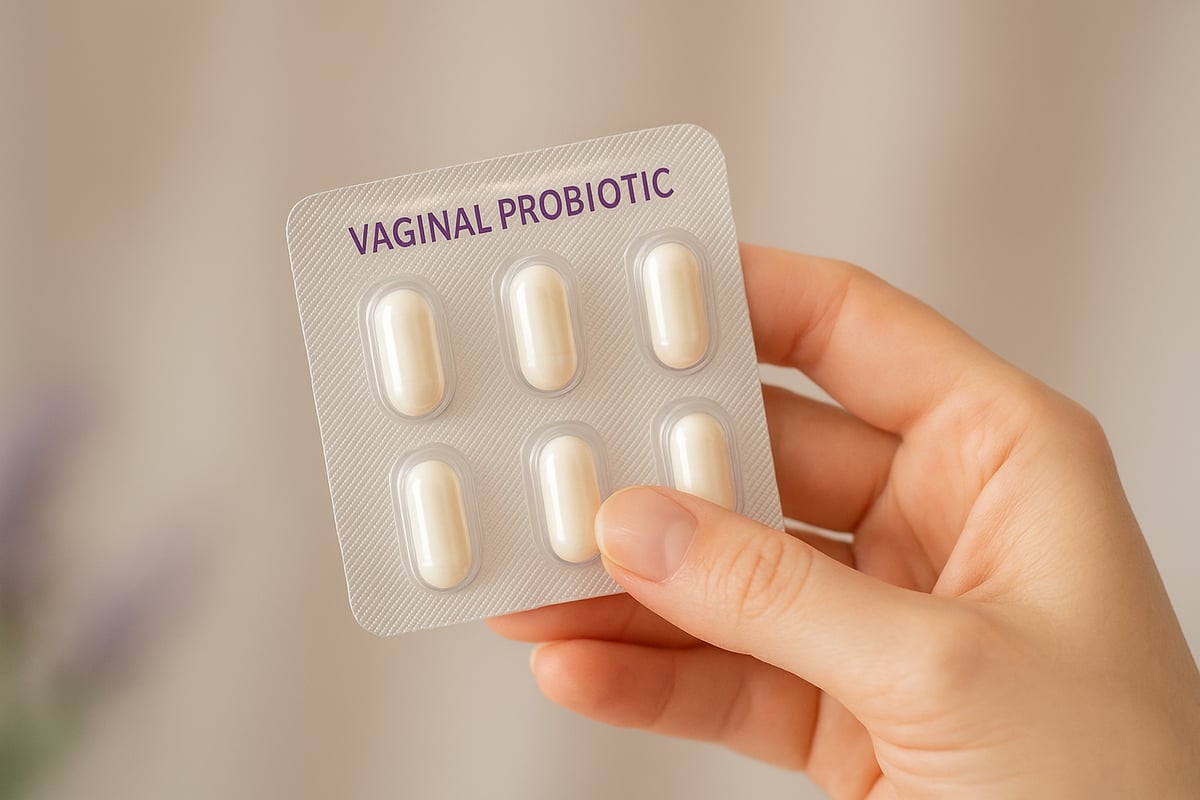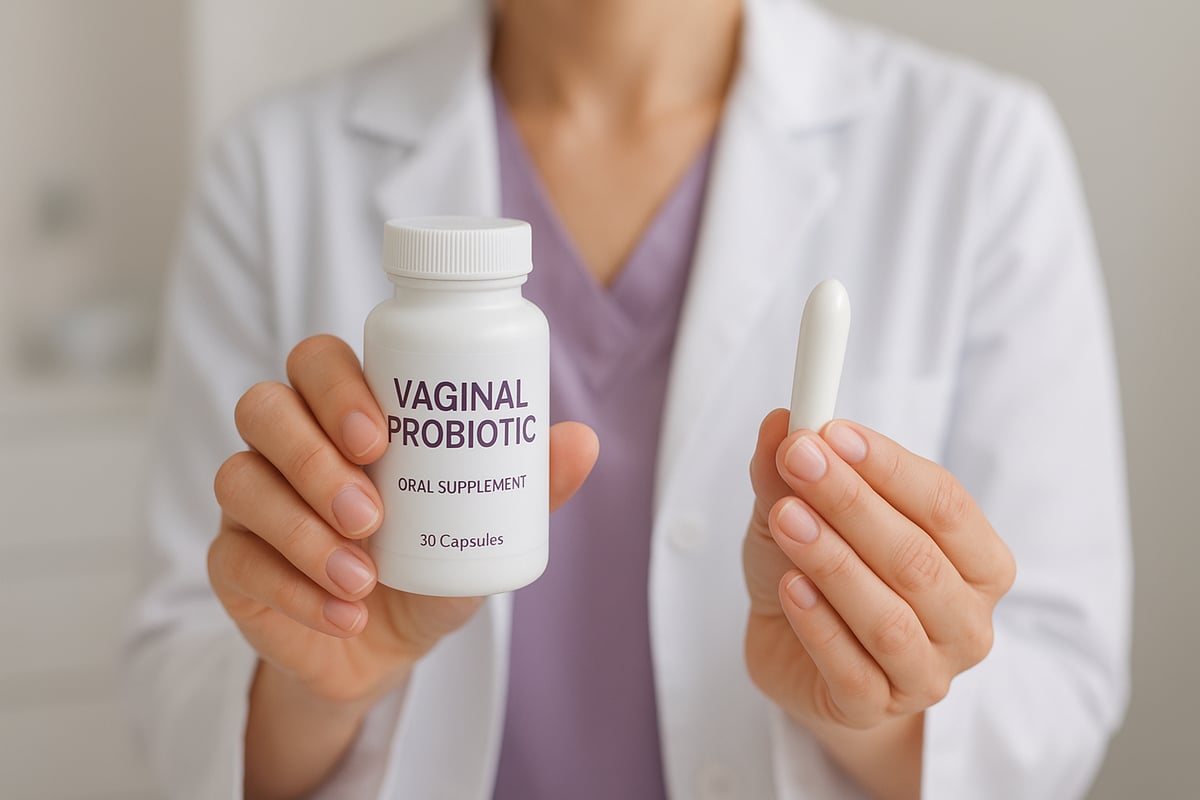
Vaginal Probiotics Guide: Benefits, Uses, and 2025 Insights
Share
Did you know the balance of your vaginal microbiome can impact everything from daily comfort to infection risk? More women are asking how to support intimate wellness naturally, and vaginal probiotics are at the heart of this conversation.
In this comprehensive guide, we demystify vaginal probiotics, breaking down their benefits, uses, and the latest 2025 research. You’ll discover what they are, how they work, who stands to benefit, and how to choose the best options for your needs.
Imagine fewer recurrences of discomfort, better balance, and peace of mind backed by science. If you are ready to take charge of your intimate health, read on to find out if vaginal probiotics are the right choice for you.
Understanding the Vaginal Microbiome
The vaginal microbiome is a fascinating, dynamic system that plays a crucial role in women's health. Just like the gut and skin, the vaginal environment is home to a diverse community of microorganisms. These microscopic residents are essential for maintaining balance, preventing infections, and supporting overall well-being. Understanding how this system works is key to appreciating the potential of vaginal probiotics for optimal intimate health.

What is the Vaginal Microbiome?
The vaginal microbiome refers to the unique community of bacteria, fungi, and viruses living in the vagina. These organisms work together to maintain a healthy, slightly acidic environment, which protects against harmful microbes.
Much like the gut or skin microbiome, this ecosystem is not static. It shifts in response to age, hormone levels, lifestyle, and health status. For example, microbial communities change significantly during puberty, pregnancy, and menopause. Researchers often describe five Community State Types (CSTs), each defined by which bacterial species are most abundant.
These shifts can influence how effective vaginal probiotics are at different life stages. To learn more about how vaginal microbiota composition varies across reproductive phases, see this comprehensive analysis.
Key Players: Lactobacilli and Bifidobacteria
Among the many microbes present, Lactobacilli are the most dominant in 70 percent of healthy women of reproductive age. Key species include L. crispatus, L. gasseri, L. iners, and L. jensenii. These bacteria produce lactic acid, which keeps the vaginal pH low and helps block the growth of pathogens.
Bifidobacteria, though less common, are found in 5 to 10 percent of healthy vaginal microbiomes. They may also help protect against infections. For instance, L. crispatus is strongly linked to reduced infection risk.
Most vaginal probiotics are formulated with these specific strains, as four out of five CSTs are dominated by Lactobacilli. The right balance of these microbes is essential for resilience and comfort.
Table: Dominant Bacterial Populations by CST
| CST Type | Dominant Bacteria | Prevalence (%) |
|---|---|---|
| I | L. crispatus | High |
| II | L. gasseri | Moderate |
| III | L. iners | Moderate |
| IV | Diverse/Low Lactobacilli | Variable |
| V | L. jensenii | Low |
What Causes Vaginal Dysbiosis?
Dysbiosis occurs when the natural balance of the vaginal microbiome is disrupted. Common triggers include hormonal changes, antibiotics, douching, and new sexual partners. When this balance shifts, harmful bacteria like Gardnerella vaginalis, Atopobium vaginae, or Prevotella can multiply, leading to bacterial vaginosis (BV). Other pathogens such as Group B Streptococcus or E. coli may cause aerobic vaginitis (AV).
Symptoms of dysbiosis often include unusual odor, discharge, and discomfort. It is important to note that both beneficial and harmful bacteria can coexist, making the ecosystem complex.
Data shows that up to 50 percent of women experience BV recurrence within six months after antibiotic treatment. This highlights why many turn to vaginal probiotics for additional support in restoring and maintaining healthy flora.
Vaginal Probiotics: What They Are and How They Work
Understanding vaginal probiotics begins with their unique purpose. Unlike standard probiotics made for gut health, these are designed specifically for the vaginal environment. Their role is to help maintain balance, support natural defenses, and restore harmony when things go off track.

Definition and Types of Vaginal Probiotics
Vaginal probiotics are live microorganisms formulated to benefit the vaginal ecosystem. Unlike gut probiotics, these strains are chosen for their ability to survive and thrive in the vaginal setting. They are available as oral supplements or direct vaginal suppositories.
Key strains include Lactobacillus crispatus, L. rhamnosus, L. reuteri, and L. gasseri. Each has been studied for its role in supporting a healthy vaginal environment. For example, Lactin V, which contains L. crispatus, is an intravaginal probiotic designed to target bacterial imbalance.
Vaginal probiotics are tailored for optimal colonization, and their formulation reflects the unique needs of vaginal health. Choosing the right type depends on individual health goals and consultation with a healthcare provider.
Mechanisms of Action
Vaginal probiotics work in several science-backed ways to support balance. First, they help restore healthy bacteria populations after disruptions, such as antibiotic use or episodes of dysbiosis. These probiotics produce lactic acid, which keeps vaginal pH acidic and deters harmful microbes.
Another key mechanism is competitive exclusion. Vaginal probiotics occupy available space and block pathogens from attaching to the vaginal lining. They also produce antimicrobial compounds, like bacteriocins, that directly inhibit unwanted bacteria.
By supporting immune responses in the vaginal mucosa, these probiotics help the body resist infections. For instance, research shows that L. crispatus can reduce the recurrence of bacterial vaginosis. For more on how microbial imbalances impact vaginal health, see Vaginal microbiota in infections.
Forms, Delivery, and Survival
Vaginal probiotics come in oral and vaginal forms, each with unique considerations. Oral supplements must survive stomach acid and passage through the gut, which can affect their effectiveness. Direct vaginal suppositories offer a more targeted approach, delivering probiotics straight to where they are needed.
Combination therapy, using both probiotics and antibiotics, is sometimes recommended to help recolonize healthy bacteria. However, not all strains found in gut probiotics will successfully establish themselves in the vagina. Strain specificity is essential for results.
Clinical trials show varying cure rates depending on the population and method of delivery. Choosing a product with strains proven to colonize the vagina, such as L. rhamnosus or L. gasseri, is critical. Always look for clear labeling and evidence supporting the strain's survival and effectiveness in the vaginal environment.
Evidence-Based Benefits and Limitations
Understanding the practical value and boundaries of vaginal probiotics is essential for making informed decisions. As research continues to evolve, let us explore the most up-to-date benefits, limitations, and safety considerations for these supplements.

Proven and Potential Benefits
Vaginal probiotics have demonstrated multiple promising benefits for women’s intimate health. Clinical trials indicate they may help reduce the recurrence of bacterial vaginosis and urinary tract infections. This is particularly valuable for women who experience repeated infections or post-antibiotic imbalances.
Restoring healthy vaginal flora is another key advantage. Specific strains such as L. crispatus and L. gasseri support an acidic environment, which helps inhibit the growth of harmful bacteria. Some studies suggest that vaginal probiotics may even lower the risk of certain sexually transmitted infections by maintaining a robust microbiome.
For example, Lactin-V, a targeted probiotic containing L. crispatus, has shown positive results in reducing repeat BV and UTIs in clinical settings. While outcomes are most notable with strain-specific products, small-scale studies continue to report improved vaginal health across various populations. The potential for vaginal probiotics to support long-term wellness is an area of growing interest.
Limitations and Controversies
Despite encouraging findings, there are several important limitations to keep in mind regarding vaginal probiotics. Many commercial products make bold claims without strong scientific backing or FDA approval. Most available research is limited by small sample sizes, short study durations, or the use of strains originally designed for gut health rather than the vaginal environment.
Efficacy can vary widely depending on the probiotic strain, dosage, method of delivery, and individual patient factors. Additionally, the placebo effect and inconsistent outcomes across different regions contribute to ongoing debate. Probiotics should never replace prescription treatments for active infections.
The need for greater research diversity is also critical. As highlighted in Diversity in vaginal microbiome research, more inclusive studies are needed to ensure findings benefit women of all backgrounds. Regulation remains a concern, as supplements are not required to prove effectiveness before reaching the market.
Safety and Side Effects
For most healthy women, vaginal probiotics are considered safe and well-tolerated. Mild digestive symptoms, such as bloating or gas, may occur with oral supplements, but these effects are typically temporary. Rarely, individuals with compromised immune systems may face a risk of infection from probiotic use.
Choosing reputable brands that use clinically tested strains and transparent labeling is crucial for minimizing risk. Vaginal probiotics are not recommended as the sole therapy for active infections and should not replace medical care. Women with allergies to specific ingredients should read product labels carefully.
It is always best to consult a healthcare provider before starting any new supplement, especially during pregnancy or for those with underlying health conditions. With thoughtful use, vaginal probiotics can be a valuable addition to a well-rounded approach to intimate wellness.
Who Can Benefit from Vaginal Probiotics?
Choosing to use vaginal probiotics is a personal decision, often guided by your health history and current symptoms. Understanding who stands to benefit most can help you decide if these supplements are right for your needs.

At-Risk Populations and Use Cases
Certain groups are more likely to experience disruptions in vaginal health, making vaginal probiotics particularly helpful. These include:
- Women with frequent bacterial vaginosis (BV) or yeast infections
- Those who suffer from recurrent urinary tract infections (UTIs)
- People experiencing hormonal changes such as pregnancy or menopause
- Individuals who use antibiotics or engage in practices like douching
- Women with new sexual partners or who want preventive support
Research shows that up to 50% of women experience BV recurrence within six months of antibiotic treatment. For these populations, vaginal probiotics may offer a proactive way to restore and maintain balance.
Considerations for Special Groups
Some women require extra attention when considering vaginal probiotics. For pregnant women, safety data is still limited, so consulting with an OB-GYN is essential. Postmenopausal women may benefit as declining estrogen can disrupt the vaginal microbiome, and probiotics could help restore balance.
Immunocompromised individuals should exercise caution, discussing options with their healthcare provider. For adolescents, while vaginal probiotics are generally considered safe, guidance is recommended due to limited research. Studies in postmenopausal women suggest that certain strains, like L. crispatus, may support a healthier vaginal environment. To further enhance wellness, consider integrating holistic wellness habits for women alongside probiotic use.
When to Avoid or Use with Caution
Vaginal probiotics are not suitable for everyone. Avoid use during active infections that require prescription treatment, or when facing severe immunodeficiency or serious health conditions. Allergies to probiotic ingredients are another reason to steer clear.
Choose only products with transparent labeling and clinical testing. If you are uncertain, always consult a healthcare provider. Used appropriately, vaginal probiotics can be a safe addition to your wellness plan, but medical oversight is key for those with complex health needs.
How to Choose and Use Vaginal Probiotics in 2025
Choosing the right vaginal probiotics in 2025 requires a careful look at product quality, usage instructions, and how they fit into your overall wellness plan. With new research and a growing variety of options, understanding what sets a reputable product apart is essential for making confident decisions.
What to Look for in a Quality Product
When selecting vaginal probiotics, focus on products tailored specifically for the vaginal environment. Not all probiotics are created equal, so consider these important features:
| Feature | Why It Matters | Example |
|---|---|---|
| Strain specificity | Only certain strains colonize the vagina effectively | L. crispatus, L. gasseri |
| Delivery method | Oral and vaginal forms offer different benefits | Suppository, capsule |
| CFU count | Effective doses are usually in the billions | 1-10 billion CFU |
| Third-party testing | Ensures safety and potency | Verified by labs |
| Transparent labeling | Full disclosure of strain, dose, and expiration | Clear ingredient list |
| Clinical evidence | Backed by published research | Lactin-V, clinical trials |
Opt for brands that provide detailed information, including clinical studies and third-party testing. If you have questions about ingredients or quality, consult FAQs on holistic health and supplements to make informed choices about vaginal probiotics.
Step-by-Step Guide to Using Vaginal Probiotics
Using vaginal probiotics is most effective when you follow a systematic approach:
- Identify your goal: Are you aiming for prevention, recovery after antibiotics, or overall health?
- Choose the right strain and delivery: Select strains proven for vaginal health and decide between oral or vaginal application.
- Read instructions carefully: Follow dosage guidelines and duration recommendations on the product.
- Monitor your response: Watch for benefits or any mild side effects.
- Seek medical advice if needed: If symptoms persist or worsen, consult your healthcare provider.
- Adopt healthy habits: Pair probiotic use with practices that support the vaginal microbiome, such as avoiding douching and practicing safe sex.
Following these steps can help you integrate vaginal probiotics safely and effectively into your care routine.
Integrating Probiotics into Your Wellness Routine
For lasting results, vaginal probiotics should become part of a broader self-care strategy. Consider these key habits:
- Combine probiotics with a balanced diet and proper hygiene.
- Avoid using harsh soaps or douching, which can disrupt the vaginal microbiome.
- Track your symptoms and adjust usage as needed.
- Ongoing use might be needed for those with frequent recurrences.
- Take a holistic approach to women’s health, blending probiotics with other wellness practices.
For more ideas on building a consistent self-care regimen, explore tips for building a daily wellness routine that support your entire body, including intimate health.
2025 Insights: Trends, Research, and the Future of Vaginal Probiotics
The world of vaginal probiotics is rapidly evolving in 2025, with new research, regulatory changes, and emerging technologies shaping the future of women’s intimate health. Let’s explore the latest developments, what’s driving innovation, and how personalized solutions are redefining care.
Latest Research and Clinical Trials
Recent clinical trials are focusing on the precision and effectiveness of vaginal probiotics, especially strain-specific products like L. crispatus. Researchers are investigating how these strains can reduce the recurrence of bacterial vaginosis and urinary tract infections, and how long-term colonization can be achieved.
Personalized probiotics are gaining traction, with studies exploring how an individual’s unique vaginal microbiome profile can guide tailored interventions. Combination therapies, which use probiotics alongside antibiotics, are showing promise in improving outcomes and restoring balance more effectively.
Long-term benefits and sustained colonization remain top priorities for scientists. For those interested in how diagnostics are shaping these breakthroughs, the field of vaginal microbiome diagnostics is opening new doors in fertility, pregnancy care, and infection prevention.
Regulatory and Market Trends
The landscape for vaginal probiotics is shifting as demand grows for natural, evidence-based solutions. Regulatory agencies are increasing scrutiny of product claims, pushing manufacturers to provide stronger scientific backing for their formulations.
In 2025, there is a clear movement toward FDA-approved vaginal probiotics, with more companies investing in clinical trials and transparent labeling. The market is also seeing innovations in delivery methods, such as custom-tailored strains and convenient subscription-based services.
Here’s a quick comparison of market trends:
| Trend | Impact in 2025 |
|---|---|
| FDA scrutiny | Higher product quality |
| Personalized formulations | Greater effectiveness |
| Subscription models | Improved access |
Consumers are becoming savvier, seeking out products with proven efficacy and reliable sourcing.
The Future: Personalized and Preventive Care
Looking ahead, personalized care is set to revolutionize the use of vaginal probiotics. Advances in microbiome testing will allow women to receive individualized recommendations based on their specific needs. Integration with digital health platforms will make it easier to track symptoms, receive guidance, and adjust routines in real time.
There is growing interest in the potential of vaginal probiotics for broader applications, including STI prevention, fertility, and pregnancy support. Holistic approaches are gaining ground, emphasizing the importance of maintaining a balanced microbiome for overall well-being. For a deeper dive into how diagnostics and innovation are advancing this field, explore more about vaginal microbiome diagnostics.
Despite exciting progress, experts stress the need for larger, more diverse clinical trials to validate the long-term benefits of vaginal probiotics. As science and technology advance, women can expect more precise, preventive, and empowering options for intimate health.
As you’ve seen, nurturing your vaginal microbiome is a key step toward feeling comfortable, balanced, and resilient every day. The right probiotic can help you restore harmony, support your body’s natural defenses, and keep you in tune with your wellbeing goals—especially as new research and innovations emerge in 2025. If you’re ready to bring your body back to balance, consider taking the next step with clean, plant-based support designed for your unique needs.
